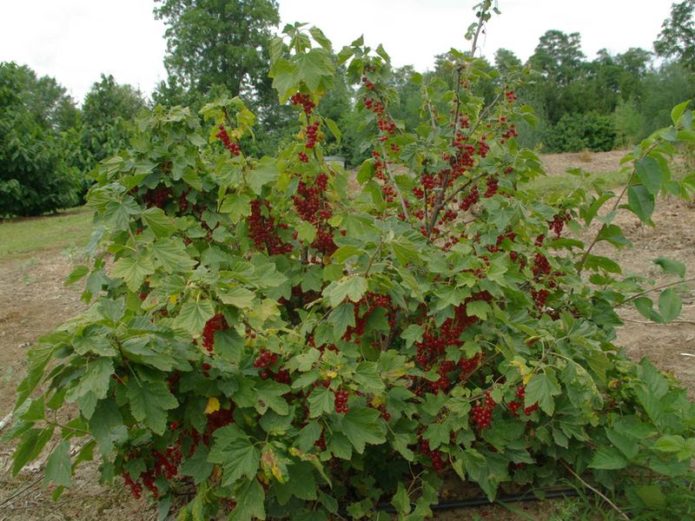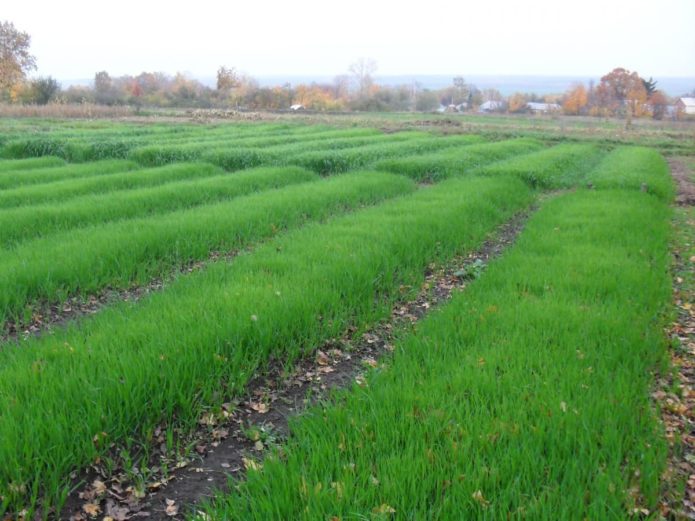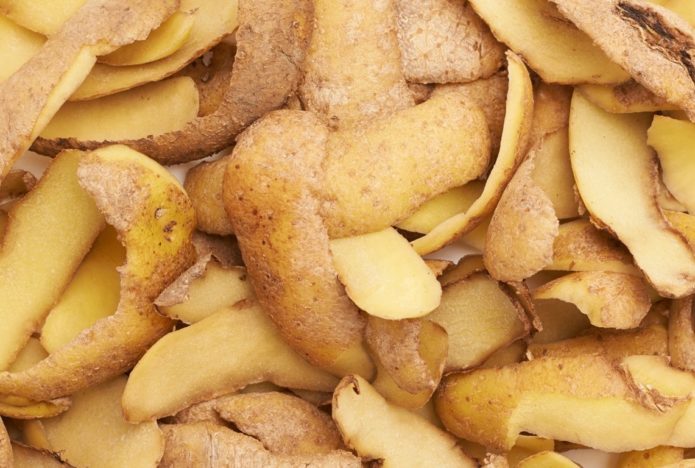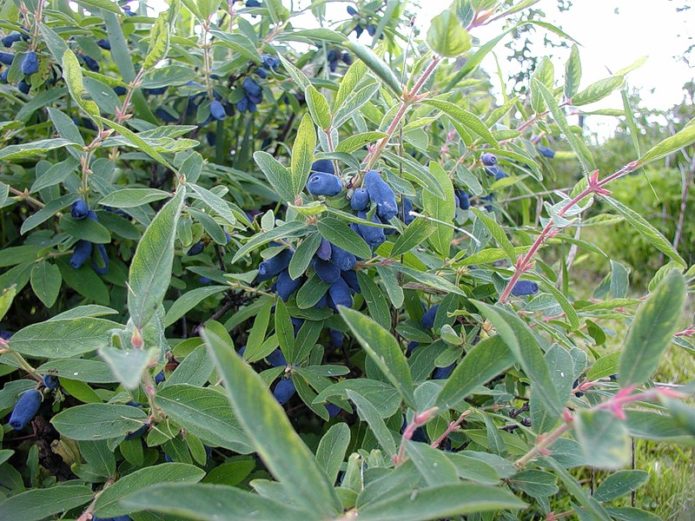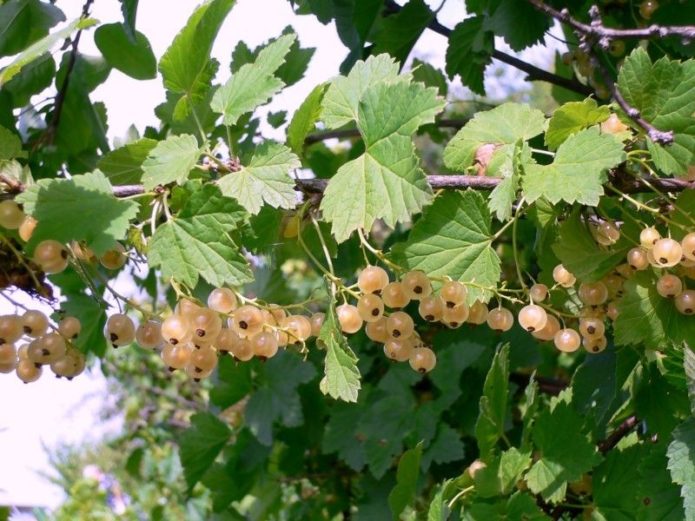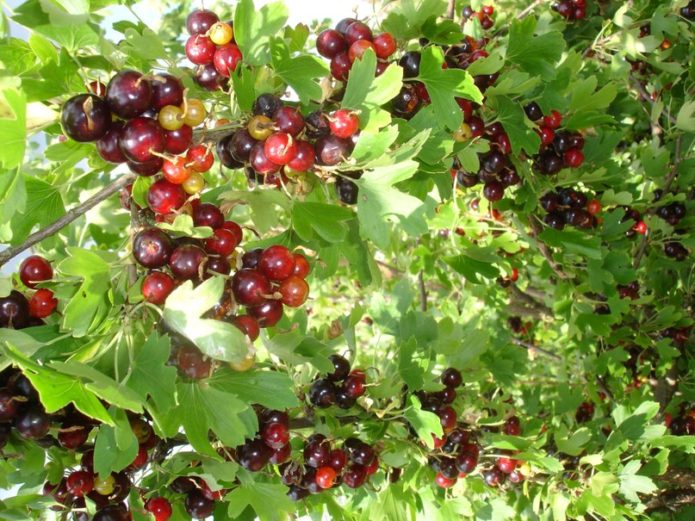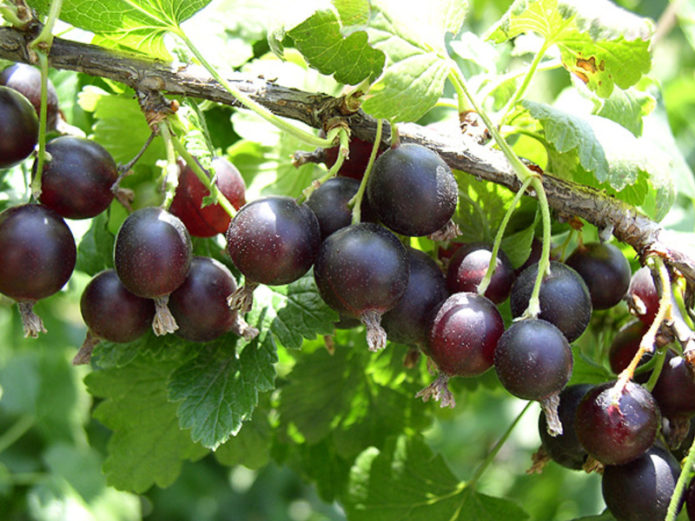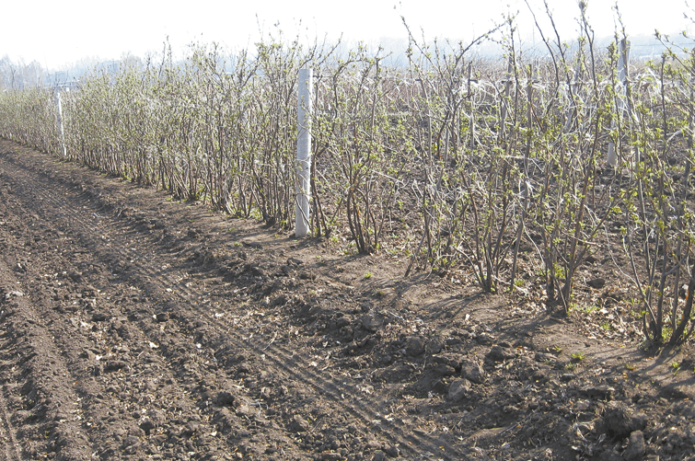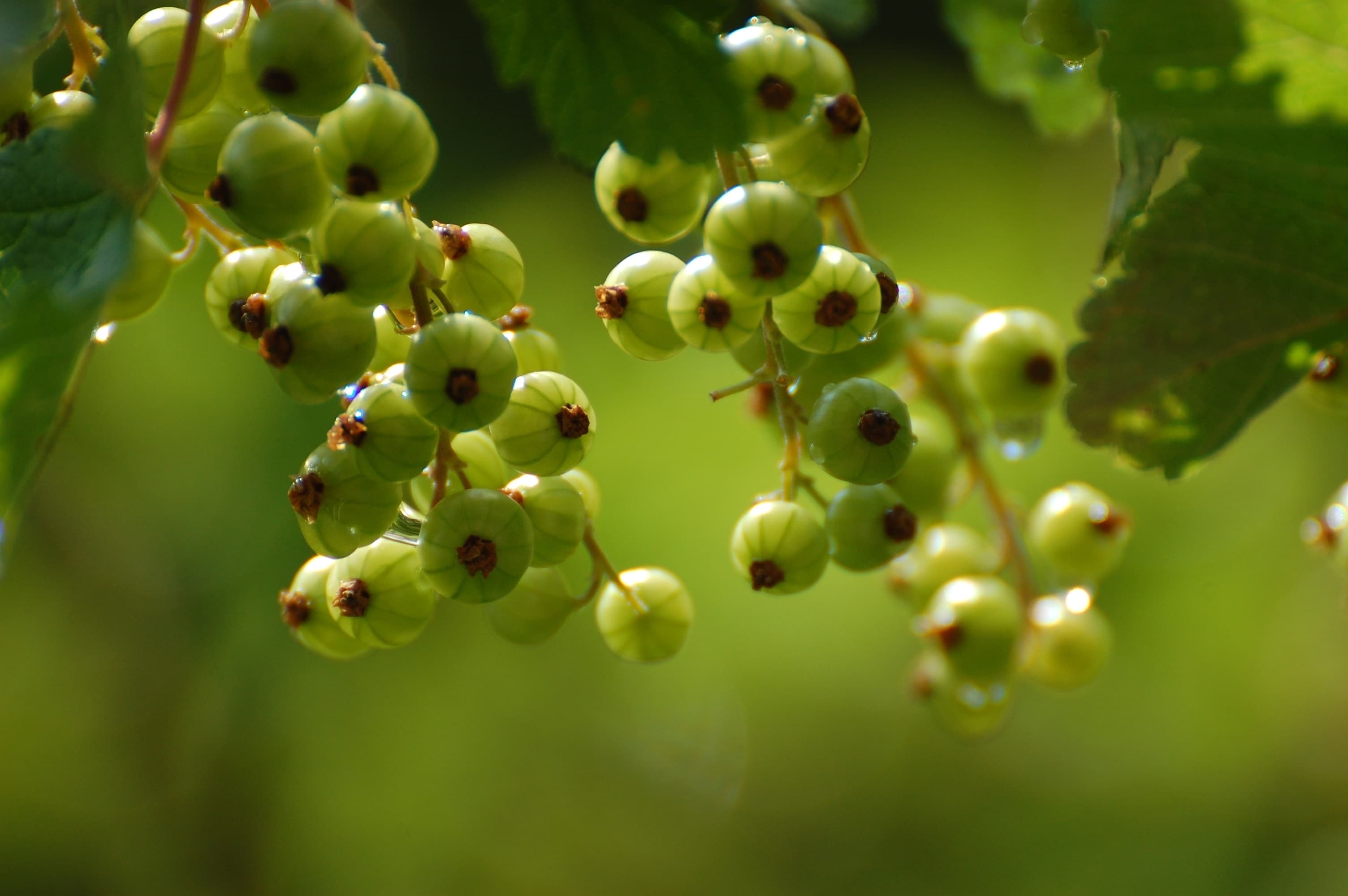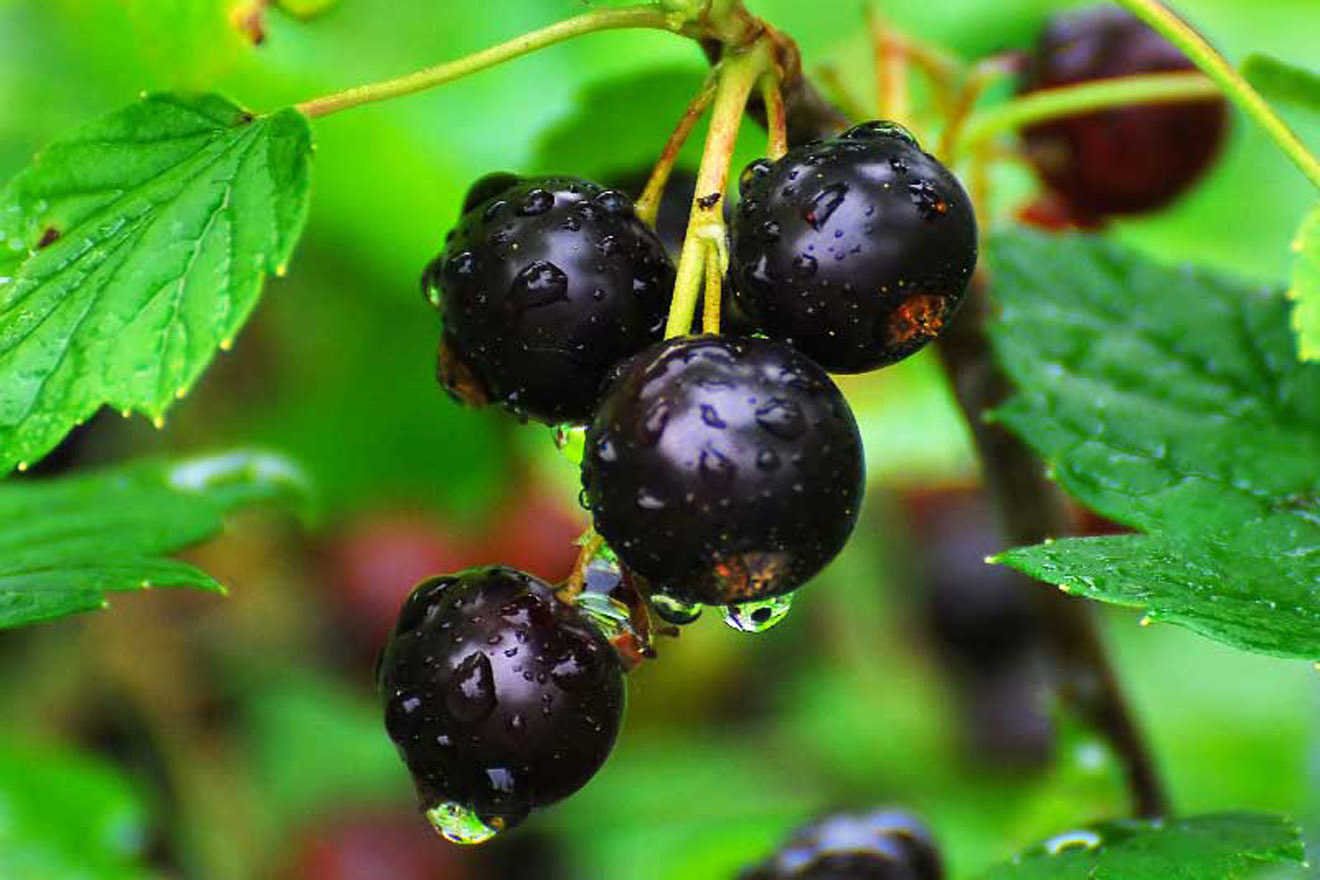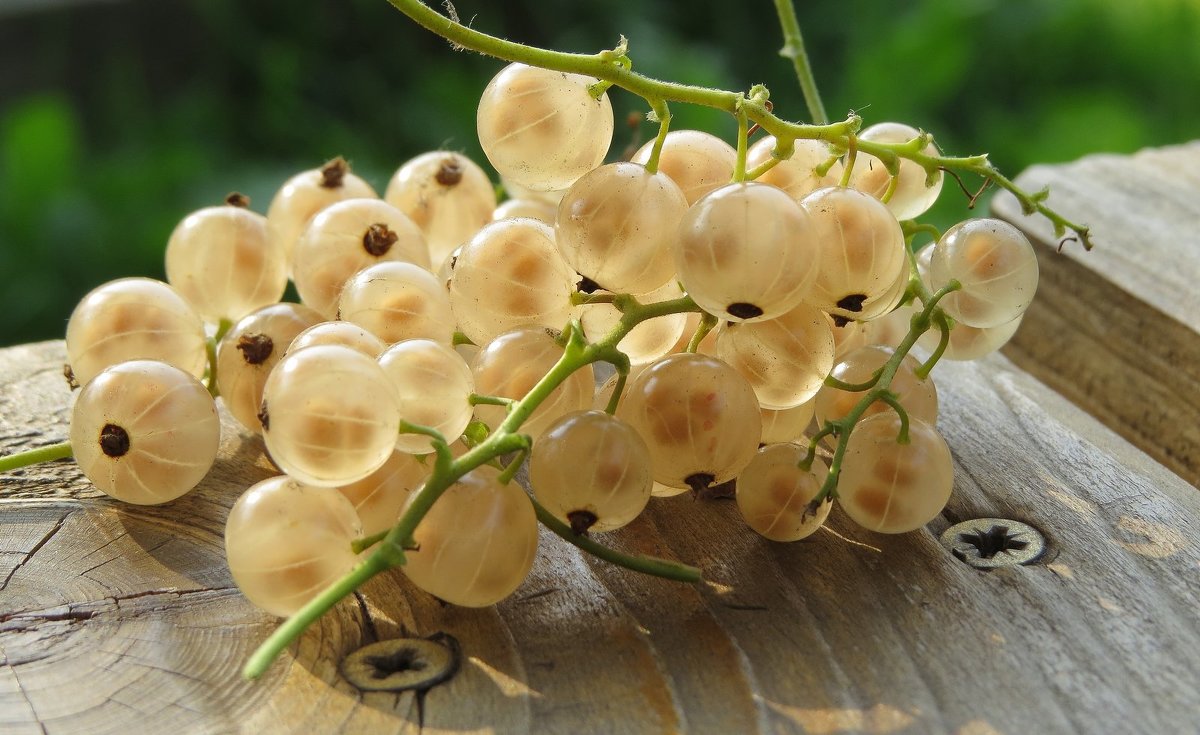The currants are planted in a new plot as one of the first crops. It is not difficult to plant it, and the harvest will be soon. In a few years, it will even be measured in buckets. The bush bears fruit in one place for up to 20 years, after which the bushes must be updated. Consider the basic planting rules that allow you to get a guaranteed yield of vitamin berries.
Content
Currant planting technology
Black currant is a fairly hardy and the most hardy plant of all berry bushes. For her, you should choose wet areas, but without stagnant water. Red and white currants are more drought-resistant, higher, well-lit and less humid areas are suitable for them. Currant plantations should be protected by natural or specially planted tree plantations, especially from the prevailing winds. In winter, protective plantations contribute to a greater accumulation of snow, less freezing of the soil, and in summer they reduce the drying effect of winds and dry winds.
Where to plant currants on the site
Different types of currants differ slightly in their location requirements and other growing conditions. European black currant prefers low, but not wetlands, and varieties of Siberian currants grow well and bear fruit in elevated, but sufficiently humid places. Red currants grow best on the lower parts of slopes or on level elevations. Black currant tolerates a light shade, but in highly shaded places its shoots stretch out, very few flower buds are formed, as a result of which it bears poorly. In summer cottages, it is often planted between rows of young trees. In old gardens, currants require a free, bright place.
Red currants require good light for normal growth. It bears fruit poorly in the lowlands. The southwestern slopes are suitable for it, but not very steep. Plots allotted for any currant should not have sedge swamps in the vicinity.
In the middle zone, smooth or slightly sloped areas are allocated for currants; in areas of insufficient moisture - near water sources, protected from the wind. For her, both loamy and sandy loam soils are suitable, but always well-cultivated, fertile. Black currants work better on heavy loams, and white and red ones - on light loams and sandy loams.Areas with high acidity (pH less than 5.5) are unsuitable, as well as those where groundwater is closer than 1–1.2 m from the surface. You should not plant currants in low areas, as this can lead to spring freezing of already blossoming flowers. All varieties of red currant are less demanding on water than black. In the central chernozem regions and further to the north, they bear fruit abundantly even without irrigation.
At the summer cottage, it is not required to plant a lot of bushes, therefore, usually one row is given to the currants, often along the fence. It is good if the fence is deaf and located in such a way that it protects the plantings from the wind, but does not block the sunlight too much. It should be borne in mind that over time the bushes will grow, so you should not plant very close to the paths: you will have to move the path in a few years. In addition, one must remember about the convenience of harvesting, and there is usually a lot of it, and you will have to spend several hours near the bushes.
Differences and features of planting black, red and golden currants: https://flowers.bigbadmole.com/en/yagody/smorodina/posadka-smorodinyi-vesnoy.html
Preparing the soil for planting currants
For black currant, moisture-absorbing soil is required, red loves lighter loam or sandy loam rich in humus. Soils poorly suitable for it are improved with peat, lime, sowing green manure. It is very important to thoroughly clean the soil of weeds, especially perennial ones, before planting any types of currants: wheatgrass, sow thistle, dandelion and others. Weeds can drown out plantings, as a result of which the bushes begin to dry out early and die as a result.
Based on this, it turns out that the preliminary preparation of the soil consists in its deep cultivation. If there is no hurry, then this should be done long before planting the bushes. Digging with fertilization is carried out to a depth of at least 40 cm. Acidic soils are limed, especially before planting black currants. If there is a whole summer before planting, the best way out is to sow annual grasses on the site. Lupine, clover, oats are optimal. Preventing them from blooming, the grasses are mowed and dug up together with the ground, creating additional nutrition for future plantings and revitalizing the soil.
For autumn planting, it is necessary to completely cultivate and plan the site, as well as prepare the planting pits 15–20 days before planting, so that the soil in the pits has time to compact enough, and the soil microorganisms and earthworms properly master a new place of residence for themselves and start their useful activities ... Instead of holes, if it is more convenient, planting furrows are sometimes dug along the entire length of the future row of bushes.
Fertilizers applied when planting currants
Currants need soils that are rich in all nutrients. However, the preferences for different types of currants are somewhat different. Black currant is more partial to phosphorus nutrition, and red one loves a lot of potassium. Therefore, for black currants throughout the site, they are applied per 1 m2 about 8-10 kg of organic fertilizers, 200 g of superphosphate and 40 g of potassium sulfate, and for red and white superphosphate they take less (100-150 g), but more potassium sulfate (up to 80). Approximately the same doses are then applied to the planting pits. In no case should we forget about wood ash - an excellent source of potassium and a number of other nutrients. Ash is never superfluous. Both when digging and in pits, it can be added in very large quantities: up to a liter can, or even more.
Household waste such as peeling potatoes is an excellent fertilizer for many shrubs and for currants in particular. What an ordinary person immediately throws away, an experienced gardener zealously collects. The peel of potatoes contains almost a full range of trace elements useful for berry plants: phosphorus, iron, potassium, magnesium, etc.Of course, just putting them in a bag will not work, they will rot. Therefore, the cleaning is dried all winter (you can freeze it), and as soon as possible they are taken to the site. Potato peelings are most useful as a top dressing, but they can be placed in the planting pit during planting. A couple of handfuls of dry peels per bush will be enough to get you started.
After marking the cultivated area, they begin to dig holes. The width of the pit for currants is 30–40 cm, the depth is at least 30, but better, especially on clay soils, up to 50 cm. The bulk of the working roots of the currant is quite shallow, and the roots also go not far to the sides, not further than the crown of the bush. They try to dig holes round, although this is not necessary. As with any plantings, the top layer of soil is folded in one direction, and the less fertile bottom layer in the other, bad soil is not returned to the pit. Fertilizers are applied to a pile of fertile soil before planting currants and thoroughly mixed.
Fertilization for currants in spring, summer and autumn:https://flowers.bigbadmole.com/en/yagody/smorodina/podkormka-smorodinyi-vesnoy.html
Timing and scheme of planting currants
Like most berries, plant currants in autumn or in the spring. But since currants wake up very early in spring, autumn planting is much more attractive.
Planting currants in autumn
In the middle zone, planting begins at the end of September and ends two weeks before the onset of stable frosts. Autumn planting is more favorable for plant survival. In the spring, they begin to grow as soon as the snow cover has melted and warm days come. In the fall, abundant watering is not required, and in a rainy fall, it may not be done at all. Autumn weather is favorable for a leisurely planting of currants, it allows you to carry out all the work carefully and efficiently.
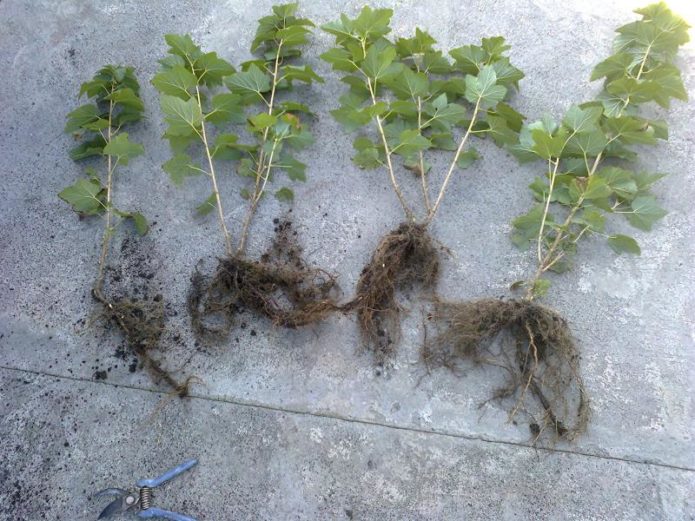
Such wonderful seedlings should not be left until spring. It is better to plant them right away and correctly
Planting currants in spring
Currants can be planted in spring, but in spring there is usually not enough time for planting work. The buds of the currants bloom when it is still impossible or very difficult to work in the garden, it is completely impossible to reach some dachas due to the muddy roads. You need to wait until the roads and land on the site dry up. In addition, preparing for a quality planting takes a lot of time. During this time, the soil will lose a lot of moisture, and you have to plant bushes when it is already dry. When planting in spring, careful watering is required, and not one, but in dry years, you will often have to water it until the seedlings take root properly. In the spring, the seedlings take root worse, therefore, failures may overtake, some of the bushes will disappear. On those summer cottages, where the owners often visit, spring planting is quite acceptable, if only it is carried out in a timely manner and strictly according to the rules.
Lunar calendar for planting currants
Many gardeners firmly believe in the lunar calendar and check all their summer cottages with the phases of movement of the natural satellite of the Earth. It is difficult to 100% agree that it is obligatory to do this, but, apparently, there is something in it. Although, of course, it is impossible for a working person to tie all his troubles to the lunar calendar, otherwise he can be left without a crop at all, and bring radishes and cucumbers bought at the bazaar to the barbecue.
The most unsuitable phases for planting garden plants are the new moon and full moon. Actually, astrologers make a start from this rule when drawing up calendars. It is believed that you can take care of fruit trees and shrubs when the Moon is in the constellations of Aries, Leo and Sagittarius. It is advisable to plant shrubs when the Earth's satellite decreases.
Based on this, for example, for 2018, planting currants in the spring is recommended on the following dates of March: 23, 26-29. In April it is 5-7 and 9-11 numbers. Of the autumn dates, 27-29 September, as well as 4-8, 10-17, 22-24 October are interesting.
Currant planting scheme
The optimal placement of currant bushes depends on the variety, soil, lighting. When planting currants, the following approximate distances are taken. Red currant: for white-fruited varieties 2 x 1.25 m, red-fruited - 2 x 1.5 m. Black currant - 2.5 x 1.5 m. The efficiency of joint placement of several inter-pollinated varieties has been noticed; this approach increases the yield and its quality. Therefore, on the site there should be 2-3 varieties of different ripening periods.
An adult bush occupies a considerable area: you need to be guided that with good care, the bushes planted according to the recommended scheme will close in a row, and in the aisles from the base of the bush they will occupy at least one meter. This must be taken into account in the case of a very attractive planting of currants along the fence. After all, from the side of the fence, you will also need to harvest! Therefore, the minimum recommended in many horticultural charters for planting bushes - 1 m from the fence or a neighboring plot - should be slightly increased. If you feel sorry for the place, then at first you can take it, for example, shade-tolerant or early spring flowers like tulips. And when the flowers grow, climbing plants (ornamental or even food beans, loach, etc.) can be put on the fence.
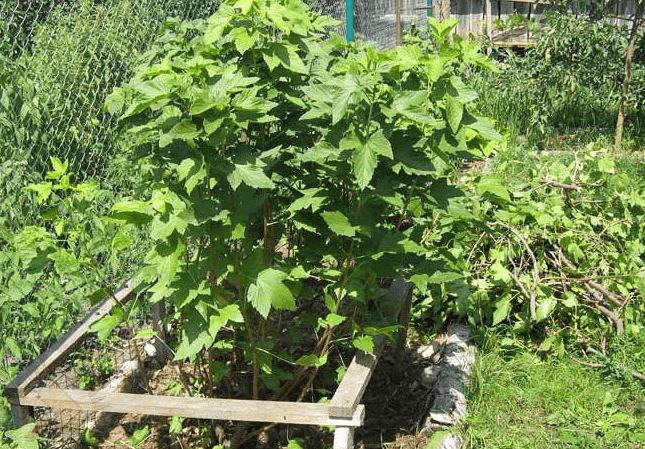
While this bush is young, you can approach the fence. But after a few years, picking berries from the back will be difficult.
What can be planted next to currants
The best precursors for currants are clover, potatoes and any vegetables. Actually, they also remain good neighbors for currants when growing them. It is difficult to name a vegetable that would interfere with the currants. Well, unless the horseradish, which, expanding, clogs all the landings around it. It is good to plant onions and garlic in the aisles of the currants. They release phytoncides to help control pests in horticultural crops.
Black currant loves the neighborhood with honeysuckle. Strawberries do not interfere with currants at all, only it grows so that instead of harvesting you will have to trample on it, getting to the currant bushes.
You should not plant black and red currants next to each other: as we already know, they have slightly different optimal growing conditions. In the case of planting next to the black currant of the gooseberry, they will normally coexist, but they have one common pest - the firefly, therefore, having settled on one plant, it will immediately settle on another. But red currants and gooseberries live peacefully with each other. It is impossible to plant nearby plants that give a lot of growth - cherries, plums, raspberries, blackberries, as well as trees that spread their roots far beyond the borders of the crown - walnut, apricot.
Gooseberry. Planting site, pit and seedling preparation, planting scheme and planting instructions:https://flowers.bigbadmole.com/en/yagody/kryzhovnik/posadka-kryizhovnika-vesnoy.html
Features of planting some varieties of currants
The currant is planted at the age of two. If the seedling has weak shoots, they are not spared, they are cut out, and the strong ones are shortened to 12-15 cm. Pruning can be done after planting, but it is better in advance: it will be easier to plant. The main stages of work are the same for any variety of currants.
Before planting, the seedlings are checked for pest infestation, damaged ones are not planted. The tips of the roots are slightly trimmed and, for better survival, they are dipped in a mash made of clay, mullein and water. A mound of good soil mixed with fertilizers is poured into the planting hole. Part of this soil is left for backfilling the roots. Plant the bush obliquely, somewhat deeper than it grew before digging, shaking slightly. Sprinkle the roots with soil and compact it well. With inclined planting, young shoots are much better born and grow. If you plant without a slope, instead of a bush, a currant tree can grow: it's also not bad, but the yield on one shoot will be small, and new ones will practically not grow.
After filling up the roots, the seedlings are watered, spending about half a bucket of water on the plant, after which the soil is poured to the top of the pit. Bumpers are formed around the bush and watered again. Mulch with humus or simply sprinkle with dry earth. In case of dry weather, repeat watering after a few days.
Planting white currants
White currant is not a separate species, but only a variety of red currant. Red currant varieties come in a variety of colors from pure white or amber to pink and dark red. White currants are sweeter than red ones. Its taste is more delicate, it is usually eaten fresh.
White currants are quite hardy. It is often found in the wild in the central zone of Russia and in Belarus; it loves to grow along the banks of rivers. Cultivated varieties of white currants are grown in gardens in sunny and non-swampy areas. When choosing a place, one must take into account that its bushes live and bear fruit for a long time: often more than 20 years. White currant annually gives new strong shoots that are capable of producing crops for 6-8 years. The horizontal roots of the white currant slightly extend beyond the projection of the crown, which is almost never the case with the black currant.
White currants are best planted in September - sometimes even from the first days of autumn. A well-lit area is assigned to her. The soil should be fertile enough, loose, have a slightly acidic or neutral reaction. The entire area is dug up in advance with the introduction of the usual doses of fertilizers for currants. The planting hole is prepared up to half a meter in diameter and at least 40 cm deep. The planting technology does not differ from that for other varieties of currants, but it is better to soak the seedlings in water for about a day before planting. The bushes are planted every 1–1.5 m, leaving only 4–5 buds above the ground on each shoot.
Planting golden currants
The leaves of this currant and even its berries are somewhat reminiscent of a gooseberry, but it is not any hybrid, but is a separate species from the Gooseberry family - golden currant. A shrub up to 2.5 m high has powerful long roots, almost straight shoots, drooping under the weight of the harvest during the fruiting period. The round or slightly elongated berries are yellowish to violet and sometimes almost black in color. A tail can be seen at the ends of the berries. Often, golden currants are used as hedges, but every year it also gives large yields of very tasty berries. True, they are almost not sour, because there is less ascorbic acid in this currant than in other species.
Golden currants are planted in early spring or autumn, but long before the arrival of frost. The place needs to be well lit, but it also tolerates partial shade. In the wild, golden currants are able to live where they have to, therefore, it does not impose special requirements on the soil. However, to obtain good yields, the soil must still be prepared in the same way as for planting other types of currants. The hole is dug larger than for black currant, about 60 cm in all dimensions. It should be borne in mind that these plants are large, can grow more than two meters in height and spread their crown by the same amount. For planting, 2–3-year-old seedlings are used, planting them in a row every 1–1.5 m, and maintaining a distance of up to 3 m between rows. The seedling is buried 6–7 cm when planting. do not differ from those for the usual types of currants.
How to plant a hybrid currant correctly
The most unpleasant thing about the gooseberry harvest is its thorns. Therefore, scientists have long tried to grow thornless varieties by crossing gooseberries with currants. The result was an amazing hybrid called yoshta... And for half a century now, this hybrid has been winning its place in gardens around the world.In our country, the hybrid appeared in the late 1980s. It has all the best of gooseberries and black currants. The hybrid is growing very quickly. This is a large, thornless shrub capable of forming powerful shoots that grow up to two meters per season. An adult fruiting bush has two dozen stems. The crown diameter reaches two meters, but the roots are shallow.
Planting a hybrid in the garden is just as easy as planting any other currant, you just need to take into account that the bush not only grows quickly, but also grows to a solid size. You can plant yoshta in early spring or at the very beginning of September. The site should be exposed to the sun, and the soil should be very fertile. It is believed that a hybrid will bear fruit well only when its “progenitors” - currants or gooseberries - grow nearby.
The size of the landing pit is about half a meter in diameter and half a meter in depth. Pits are dug in advance. The distance between individual plants is 1.5–2 m, but if yoshta is planted to create a hedge, then only half a meter is enough. It is not recommended to plant the hybrid in the center of the plot, so as not to shade other plants. Unlike ordinary currants, you can ignore the protection from the winds: the bush grows so powerful and stable. To fill the planting hole, the usual amounts of fertilizer are added to the fertile part of the excavated land.
The planting technique is the same as for any other currant. After planting and watering, the soil around the seedling must be mulched with a layer of 8-10 cm. The final stage of planting is pruning, leaving shoots with 2-3 buds.
Unconventional ways of planting currants
It would seem that all the issues of planting currants have long been resolved, all possible methods and techniques are well known, and what else to invent? But our gardeners love to experiment, expecting some kind of miracle. They also experiment with planting currants in their plots.
Planting currants on a trellis
Currants can be grown not only in the usual form, consisting of separate bushes, but it can be used to make a kind of "wall" that resembles a fence. For this, bushes are planted in one row very often, every 30-50 cm. But this fence is formed in such a way that it has a flat shape: the shoots growing away from it are cut out, and those that have grown in a “plane” are looked after. In the trellis method, you cannot do without the garter of the stems. You need to fix them firmly, but so that the twine does not cut and break the branches. Thus, the trellis method requires a frame made of pillars driven into the ground and stretched rows of thick wire, to which, in fact, currant stems are tied.
It would seem, why unnecessary problems and costs? The fact is, this approach has significant advantages: the branches are raised above the ground, and this improves the ergonomics in growing technology. It is easier to cultivate the soil and take care of the bushes, the conditions are better for pollination of flowers by bees (therefore, more harvest). And most importantly, the collection of berries is much easier, and they do not lie on the ground and do not get dirty.
Any strong pillars or metal pipes up to 2.5 m long are used as the base of the trellis. They are installed at a distance of at least 6 m from each other. The lower ends, driven into the ground, must be protected from corrosion. A strong wire with a diameter of 3-4 mm is attached to the posts every half a meter to tie currant branches to it.
The bush is formed over several years, leaving only shoots growing in the plane of the trellis. Spread them like a fan and tie them to wires. Unnecessary shoots are cut from the ground. Bushes care - watering, feeding, pruning.
Planting currants in tires
What they just put into old car tires! Some consider it beautiful, some just original, but many agree that such a fit makes it easier aftercare.There is some truth in this. For example, planting strawberries in a vertical pyramid of tires is already becoming a traditional fun for summer residents who have very limited areas for ordinary planting. Planting raspberries in tires helps to combat their uncontrolled growth. They also experimented with currants, but so far these experiments can hardly be considered successful.
Car tires can be used only for a fence, putting them around a bush or pulling a bush with a bicycle tire so that it does not fall apart, but planting currants in a tire filled with soil means risking freezing of the roots. If there is a large tire, say, from KamAZ, you can dig it into the ground almost entirely, and in the center, but into the ground, and not into the tire, plant a currant bush in the usual way. Then the tire can help protect the currants from creeping weeds, overgrown raspberries or cherries and even block the way for some underground pests.
Features of planting currants in different regions
Currant does not belong to the southern berries, it lives even better in the middle lane and in the not too far north than in the hot south. But the rules for planting it in different regions almost do not differ, the dates can only be shifted in one direction or another, and the number of irrigations can also be regulated. For example, in Siberia, it is necessary to take into account the possibility of freezing in snowless winters, which means that the possibility of sheltering the roots for the winter must be ensured. But this has little effect on the landing. In the arid Lower Volga region, on the contrary, the main thing is to provide currant bushes with moisture, and they are planted in the most common ways.
Speaking about the timing, we must remember that they rather depend not on the climate of the region, but on the current weather in a particular year. And yet in cold regions, including the Urals and Siberia, planting currants should be completed in late August. In the south, planting is recommended from mid-September to early October. The seedlings should find their new place about a month before frost.
In most regions of Ukraine, the soil is very fertile, and the climate, although it differs in the north and south of the country, is quite favorable for planting most fruit trees and berry bushes. The timing of planting currants in the north of Ukraine is in the spring, as soon as the ground melts, until about mid-May or in the fall from the beginning of October to frost. In the south, planting dates are more extended in the fall, while in the spring you have to try to plant as early as possible, while the earth is still saturated with moisture. Most Ukrainian gardeners prefer to plant currants in the fall. Although even a summer transplant of not too mature bushes is quite successful here.
Planting technology in Ukraine is standard, as elsewhere: starting with digging a site and ending with pruning planted bushes.
Video: autumn planting of black currant
Planting currants in a summer cottage is not particularly difficult and belongs to the usual concerns of an amateur gardener. You need seedlings, ordinary tools, time, strength and desire. And without a few currant bushes and the garden seems somehow incomplete. Therefore, if the currants are not yet growing on your site, they must be planted immediately.
